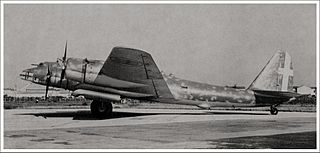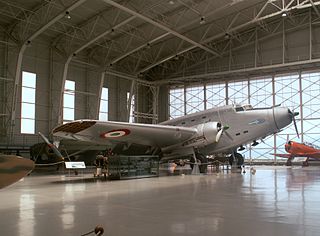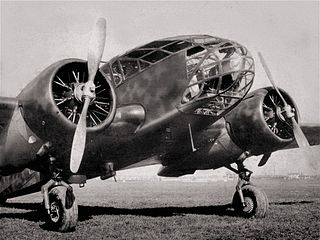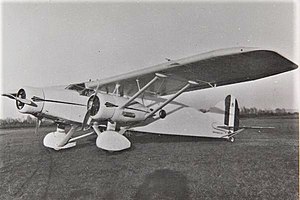
The Macchi C.200 Saetta, or MC.200, was a fighter aircraft developed and manufactured by Aeronautica Macchi in Italy. Various versions were flown by the Regia Aeronautica who used the type throughout the Second World War.

The Caproni Ca.3 is an Italian heavy bomber of World War I and the postwar era. It was the most produced version of the series of aircraft that began with the 1914 Caproni Ca.1 and continued until the more powerful 1917 Caproni Ca.5 variant.

The Savoia-Marchetti SM.81 Pipistrello was the first three-engine bomber/transport aircraft serving in the Italian Regia Aeronautica. When it appeared in 1935, it represented a real step ahead in Italian military aviation: it was fast, well armed and had a long range. It proved effective during the war with Ethiopia and the Spanish Civil War. Despite being too slow to remain competitive as a bomber in the later years of World War II, it was one of the most flexible, reliable and important aircraft of the Regia Aeronautica from 1935 to 1944, and adapted to second-line duties in a wide range of tasks.

The Fiat BR.20 Cicogna was a low-wing twin-engine medium bomber that was developed and manufactured by Italian aircraft company Fiat. It holds the distinction of being the first all-metal Italian bomber to enter service; at the time, it was regarded as one of the most modern medium bombers in the world. The British mistakenly identified this as a Fiat-Nichi Army TB-98.

The Piaggio P.108 Bombardiere was an Italian four-engine heavy bomber that saw service with the Regia Aeronautica during World War II. The prototype first flew on 24 November 1939 and it entered service in 1941. It was one of a handful of Italian combat aircraft that could match the best manufactured by the Allies. Four versions of the P.108 were designed, but only one, the P.108B bomber, was produced in any quantity before the armistice. The other variants included the P.108A anti-ship aircraft with a 102 mm (4 in) gun, the P.108C, an airliner with an extended wingspan and re-modelled fuselage capable of carrying 32 passengers, and the P.108T transport version designed specifically for military use. Only one P.108A and 24 P.108Bs were built. The combined total number of all versions was at least 39, almost certainly more than 44. Most of the P.108Cs were subsequently modified for use as military transport aircraft and could accommodate up to sixty passengers. Nine P.108 Ts were used by Luftwaffe transport units until the end of the war.

The Breda Ba.65 was an Italian all-metal single-engine, low-wing monoplane used by Aviazione Legionaria during the Spanish Civil War and Regia Aeronautica in the first half of World War II. It was the only Italian ground-attack aircraft that saw active service in this role. It saw service almost exclusively in the North African and Middle-Eastern theatre. In addition to more than 150 aircraft operated by the Italian forces, a total of 55 were exported and used by the air forces of Iraq, Chile and Portugal.

The CANT Z.506 Airone was a trimotor floatplane produced by CANT from 1935. It served as a transport and postal aircraft with the Italian airline "Ala Littoria". It established 10 world records in 1936 and another 10 in 1937. During World War II it was used as a reconnaissance aircraft, bomber and air-sea rescue plane, by the Italian Regia Aeronautica and Regia Marina, Aeronautica Cobelligerante del Sud, Aeronautica Nazionale Repubblicana and the Luftwaffe. The military version revealed itself to be one of the best floatplanes ever built. Despite its wooden structure it was able to operate in very rough seas. A number of Z.506S air-sea rescue aircraft remained in service until 1959.

The Savoia-Marchetti SM.82 Marsupiale is an Italian bomber and transport aircraft of World War II. It was a cantilever, mid-wing monoplane trimotor with a retractable, tailwheel undercarriage. There were 875 built, the first entering service in 1940. Although able to operate as a bomber with a maximum bombload of up to 8,818 lb (4000 kg), the SM.82 saw very limited use in this role. The SM.82 was the foreign aircraft used in largest number by the Luftwaffe, which operated several hundreds of this aircraft, as a transport. Post-war about 30 SM.82s continued in service with the Aeronautica Militare Italiana, many remaining in service until the early 1960s.

The Fiat CR.25 was an Italian twin-engine reconnaissance-fighter aircraft which served in small numbers for the Regia Aeronautica during World War II.

The Breda Ba.64 was an Italian single-engine ground-attack aircraft used by the Regia Aeronautica during the 1930s.

The Caproni Ca.314 was an Italian twin-engine attack/torpedo bomber aircraft, used in World War II.

The Caproni Ca.309 Ghibli was an Italian aircraft used in Libya and North Africa from 1937 to 1943. Its nickname, 'Ghibli', refers to a Libyan desert wind.

The Caproni Ca.135 was an Italian medium bomber designed in Bergamo in Italy by Cesare Pallavicino. It flew for the first time in 1935, and entered service with the Peruvian Air Force in 1937, and with the Regia Aeronautica in January 1938.

The Caproni Ca.111 was a long-range reconnaissance aircraft and light bomber produced in Italy during the 1930s. It was a derivative of the Ca.101.

The Caproni Ca.101 was a three-engine Italian airliner which later saw military use as a transport and bomber. It was designed in 1927 and first flown in 1928.

The Breda Ba.201 was an Italian dive bomber designed during World War II, that never entered production.

The Savoia-Marchetti SM.81 first saw combat during the Second Italo-Abyssinian War, where it showed itself to be versatile, serving as a bomber, transport and reconnaissance aircraft. SM.81s also fought in the Spanish Civil War with the Aviazione Legionaria and were among the first aircraft sent by the fascist powers to aid Francisco Franco.

The Caproni Ca.311 was a light bomber-reconnaissance aircraft produced in Italy prior to and during World War II.

The Caproni Ca.331 Raffica was an Italian aircraft built by Caproni in the early 1940s as a tactical reconnaissance aircraft/light bomber and also as a night fighter.
The Caproni Ca.142 was a three-engined multirole aircraft built by Caproni in the mid-1930s.




















